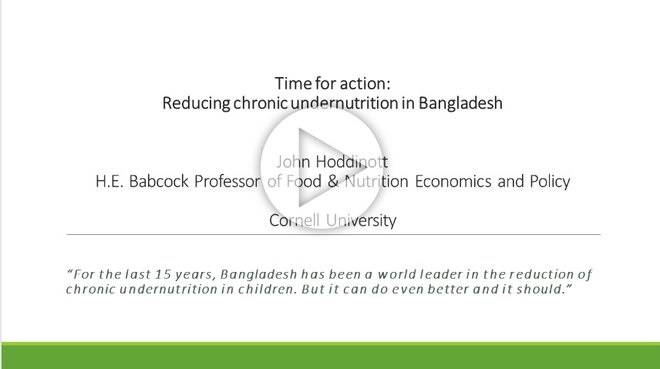Bangladesh Perspectives: Nutrition
Seminar Speakers
- John' Hoddinott is H.E Babcock Professor of Food and Nutrition Economics and Policy at Cornel University.
- Dr. Rudaba Khondker of the Global Alliance for Improved Nutrition (Gain)
Seminar Presentation by John Hoddinott:
Background
Bangladesh has been a world leader in making sure that growing children are properly nourished, but there is still a long way to go.
During the first 1,000 days of life – from conception to age two – children grow and develop very fast but, to fulfil their growth potential, they need enough of all the right nutrients. If not, both their bones and muscles grow slowly, leaving them permanently short for their age. This is known as stunting and, once it has occurred, it is irreversible. Poor nutrition in those vital early years leaves people at a permanent disadvantage over their whole lifespan.
Poor nutrition in these early years not only affects physical growth but also the development of the brain. Attention span, memory, learning capacity and the development of motor skills all suffer. Stunted children do less well at school and have lower incomes, perpetuating the cycle of poverty.
In 1997, 58% of all Bangladeshi children were stunted. By 2011, this had fallen to 40%; a big improvement but still leaving a massive problem. Fortunately, there are tried and tested ways for this to be tackled.
A large part of the problem is that mothers are themselves poorly nourished. Things which can improve the health and nutrition status of mothers and help their babies to develop properly include providing supplements of vitamins and minerals, including calcium, and adding iodine to salt. Community-based advice on breastfeeding and complementary feeding can also help.
For the babies themselves, the answer is to provide both more food but also better quality food, with vitamin and mineral supplements where needed.
For a poor country like Bangladesh, the costs are significant: about $97 for each child. But the benefits are much greater: every taka spent pays back 23 taka of benefits, and the nutrition package raises incomes by an average of 11.3%. For a Bangladeshi child born today who benefits from this nutritional package, starts work at 21 and works until 50, that’s a benefit of $2,311 in today’s money, or 23 times the money spent on the package. These benefits get bigger the longer people work.
The reduction in stunting so far is associated with several factors. About 25% of the improvement is due to increasing prosperity and 25% to better schooling and nutrition of mothers. Better healthcare and sanitation are responsible for another quarter and demographic factors and father’s schooling account for the remainder.
The nutritional package will make a real difference, but by itself will not eliminate stunting. Social protection policies in Bangladesh are an important way of reducing hunger, but don’t necessarily deliver a balanced diet. Combining social safety nets for poor families with a nutritional package can be much more effective.
A big increase in rice yields has gone a long way towards reducing hunger, but does not deliver good overall nutrition. Changing farming to produce a more varied diet could make a big contribution to reduced stunting.
And the last big factor in the equation is the status of women. Improving their education and nutrition will benefit women directly, but also have a big impact on the health and development of the next generation and, ultimately, on economic growth.


